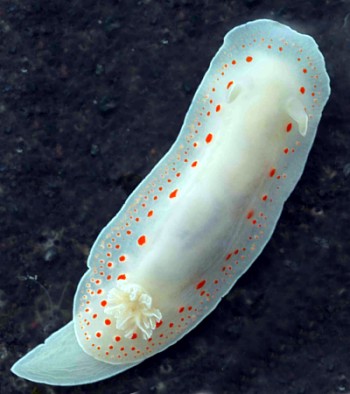
Tyrinna nobilis
Bergh, 1898
Order: NUDIBRANCHIA
Suborder: DORIDINA
Family: Chromodorididae
DISTRIBUTION
Known from northern Chile to the sthn tip of Sth America and up the Atlantic coast as far as Valdes, Argentina. Reported here from Tristan da Cunha in the Sth Atlantic.
PHOTO
Locality: The animal photographed is from intertidal pools east of Harbour, Tristan da Cunha, Intertidal and shallow subtidal to 30m, British Overseas Territory, South Atlantic Ocean, 2004-2007. Extremely exposed rocky coasts, shallow subtidal. 37 03' 50.94"S, 12 18' 43.64"W (position derived from Google Earth; note decimal seconds). Photographer: Sue Scott.
The animal is translucent white with an opaque white line around the edge of the mantle and the foot. The simple gills are also edged in white as are each rhinophore stalk and club. There are three irregular lines of or orange red spots around the mantle edge, the outermost consisting of many small spots, the middle line containing slightly larger spots and the innermost a few much larger spots. Each spot overlies an opaque white mantle gland, and there are further mantle glands which are not coverd by orange pigmentation. The central region of the mantle, between the gills and the rhinophores lacks orange spots. It is reported to grow to approximately 50 mm in length.
The main difference between T. nobilis and T. evelinae would appear to be that in the latter the orange spots are scattered all over the mantle, and if there are larger spots they are usually concentrated around the mantle edge. Where T. nobilis is found in the cold waters of the southern part of Sth America, T. evelinae replaces it in the warmer north from Mexico to Peru on the Pacific coast, and from the Caribbean to sthn Brazil on the Atlantic coast. It has also been reported from west Africa.
Chromodoris juvenca Bergh, 1898, Tyrinna pusae Marcus, 1959 are considered to be junior synonyms of this species, and Schroedl & Millen (2001) although considering Doris delicata Abraham, 1877 to be the earliest name, have invoked a section of the new Code to disregard the name.
- Muniain, C., A. Valdés, et al. (1996). Redescription of Tyrinna nobilis Bergh,1898 (Opisthobranchia: Chromodorididae) from Patagonia, Argentina. Journal of Molluscan Studies 62: 265-273.
- Schroedl, M. and S. V. Millen (2001). Revision of the nudibranch gastropod genus Tyrinna Bergh, 1898 (Doridoidea: Chromodorididae). Journal of Natural History 35(8): 1143-1171.
- Valdés, A. and C. M. L. Afonso (2003). Synonymy of Cadlina burnayi Ortea, 1988, from the Cape Verde Islands (Opisthobranchia: Chromodorididae) with Tyrinna evelinae (Marcus, 1958). The Veliger 46(2): 176-179.
Rudman, W.B., 2009 (November 18) Tyrinna nobilis Bergh, 1898. [In] Sea Slug Forum. Australian Museum, Sydney. Available from http://www.seaslugforum.net/find/tyrinobi
Related messages
More on Tyrinna nobilis from Tristan da Cunha
December 1, 2009
From: Sue Scott
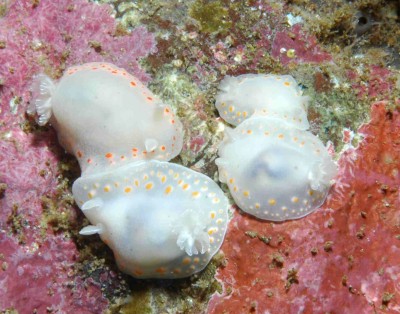
Dear Bill,
Following up on my earlier message on Tyrinna nobilis here are some photos of it from Nightingale Island, which is about 25 miles from Tristan da Cunha [message #22796].
One photo shows two mating pairs. The egg ribbons were found on the same dive where the only substantial nudis seen were Tyrinna. Not proof of course, as I didn't see them actually laying
Nightingale Island, Tristan da Cunha, British Overseas Territory, South Atlantic Ocean, 2004-2007. site N7 East Landing (approx.37 25'00.3''S, 12 28' 28.64''W) Photographer: Sue Scott.
Sue Scott
suescott153@btinternet.com
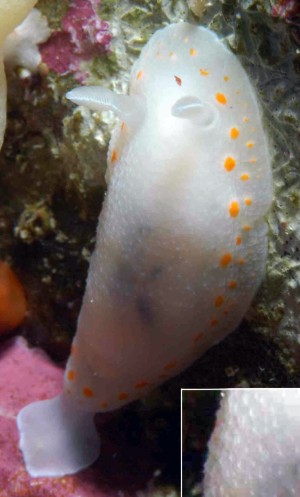

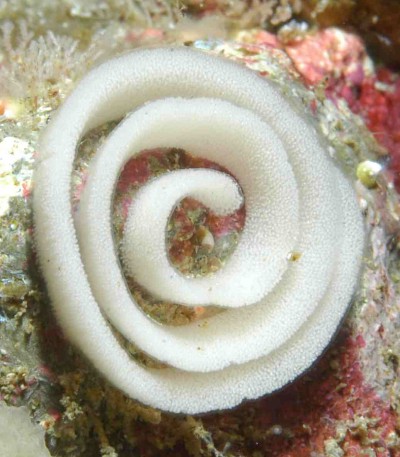
Dear Sue,
Thanks for these photos. I can't wait for your next visit. perhaps you will find Tyrinna on its food sponge. At present I suspect it feeds on a dysideid sponge because natural products chemists have isolated a sesquiterpene molecule from its mantle tissue, a molecule usually found in dysideid sponges.
While we can't be sure of the origin of the egg ribbons, they certainly fit the published description and drawing (Muniain et al, 1996) of its egg ribbon except for one feature - the direction of spiral. In the days of film cameras, photos were often reversed in various copying and printing processes and usually only noticed by people familar with the direction of shell and egg ribbon spirals. I am not sure if you used a film camera or a digital camera or if Muniain et al did. It is also possible that both of you have recorded the spirality correctly and this isn't the egg ribbon of Tyrinna nobilis.
Any clues or corrections welcome
- Muniain, C., A. Valdés, et al. (1996). Redescription of Tyrinna nobilis Bergh,1898 (Opisthobranchia: Chromodorididae) from Patagonia, Argentina. Journal of Molluscan Studies 62: 265-273.
Best wishes,
Bill Rudman
Tyrinna nobilis & others from Tristan da Cunha
November 18, 2009
From: Sue Scott
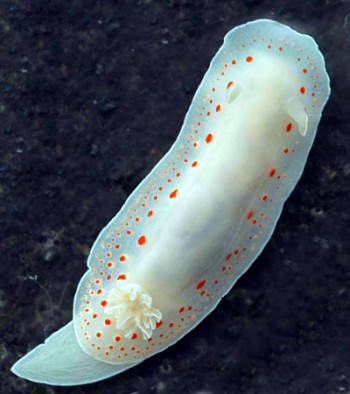
Hello Bill,
I consult your very informative website from time to time to try & identify seaslugs. I'm a marine biologist normally resident in Scotland but I've been running a marine project on Tristan da Cunha for the past few years. Because the island is so isolated and geologically young it has a weird & wonderful fauna, mostly derived from waifs & strays rafted there on marine debris, both natural and manmade. Attached are 3 photos of seaslugs from Tristan, which I have tentatively identified as Tyrinna nobilis, Doris/Anisodoris fontainei and Jorunna tomentosa. I'd be grateful for your expert opinion on these ids. Many of Tristan's animals also occur in Chile & Argentina, as is the case with the first two of these seaslugs. If the Jorunna is correct, it maybe came from the South African side.
Locality: Tristan da Cunha, Intertidal and shallow subtidal to 30m, British Overseas Territory, South Atlantic Ocean, 2004-2007 (dates available), Extremely exposed rocky coasts, shallow subtidal, diving. Photographer: Sue Scott.
The animal photographed is from intertidal pools east of Harbour, Tristan da Cunha. 37 03' 50.94"S, 12 18' 43.64"W (position derived from Google Earth; note decimal seconds)
I have also found Tyrinna nobilis on other Tristan islands:
Inaccessible Island
Site IN5, Off Blenden Hall, 37 17.223 S 012 41.711'W
Site IN6, North Point 37 16.761 S, 012 41.067 W
Nightingale Island
5 sites (N1, N2, N7, N10, N11) around Alex Island channel
Site N1 at 37 25.368 S 012 28.175 W
(positions derived from GPS; note decimal minutes)
Regards,
Sue
suescott153@btinternet.com
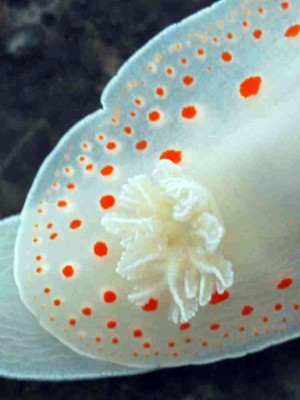
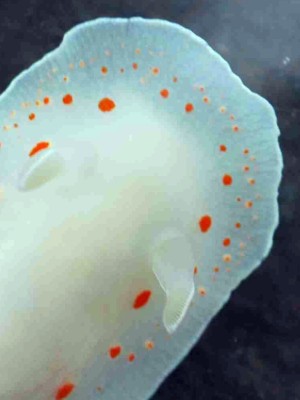
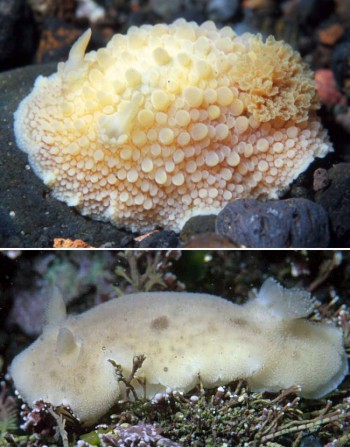
Dear Sue,
Thanks for these very interesting records and the first record of Tyrinna nobilis on the Forum. The fauna of Tristan da Cunha, stuck in the middle of the south Atlantic Ocean, must an exciting research topic. Because of the interesting locality I have split your message into three and will discuss Doris fontainei [message #22798] and the Jorunna [message #22799] separately.
Interestingly, Tyrinna nobilis and the very similarly coloured Tyrinna evelinae appear to replace each other geographically on both the west and east coasts of South America, with T. nobilis reported from most of Chile and around the sthn tip of Sth America and up the Atlantic coast of Argentina. Tyrinna evelinae by comparison is found from southern Brazil north to the Caribbean, and on the east Pacific coast from Mexico to Peru. Interestingly it has also been reported from west Africa [Ghana, and as T. burnayi from Cape Verde].
Tyrinna nobilis has not been reported from Africa, but your record from Tristan da Cunha is at least halfway there. I am not sure if anything is known of larval development in either species, but from these distributions it would appear that they have free-swimming veliger larvae.
Best wishes,
Bill Rudman
